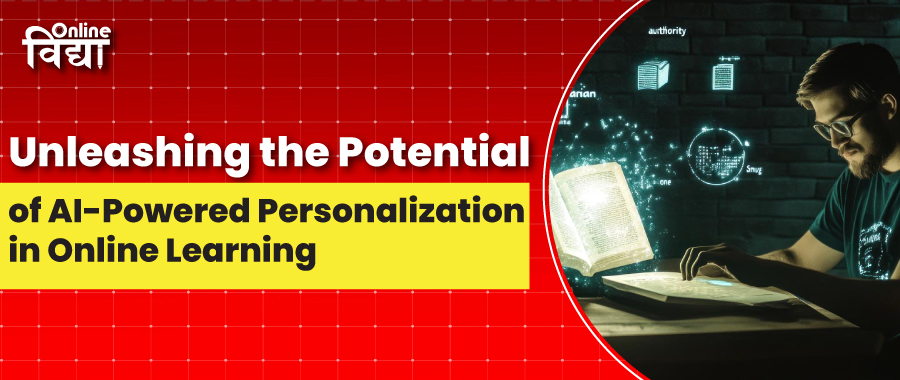Specializations
Courses Available
Courses

Unleashing the Potential of AI-Powered Personalization in Online Learning
Unleashing the Potential of AI-Powered Personalization in Online Learning,Jul 07, 2025
Information
Jul 07, 2025
1037 Views
- Share:
The education industry has undergone a significant shift over the last decade, and online education has been a resounding success globally. In 2025, one of the biggest shifts in the industry is the development of AI-powered personalization. This technology is transforming the way students learn as well as altering what schools and teachers do. In this blog, we will explore what AI-powered personalization is, its advantages, its drawbacks, and the promising future it holds for online learning.
AI-Powered Personalizations: What is this?
Learned AI-based personalization refers to the method of using artificial intelligence to develop learning experiences based on needs, interests, and levels of performance for individual students. The AI systems consider a large amount of information, such as where students interact, their performance on tests, their learning speeds, and even their emotional states, to convert teaching styles and courses to real-time courses, as opposed to the one-size-fits-all methods used earlier.
The benefits of AI training adjustment for learning online
1. Personal learning paths
One of the biggest benefits of AI personalization is that it is able to generate customized teaching passages. Each student has their way based on their goals, interests, weaknesses, and abilities. Personalization helps prevent boredom from repetitive materials and makes frustration more efficient and fun with very challenging materials.
2. A boost in inspiration and engagement
Personal learning experiences relate to students by offering content that fits their learning style and learning rates. AI can include features such as multimedia, interactive simulation, and individual responsibility. This increases suitability and commitment inspiration, reduces dropout, and promotes the tendency for lifelong learning.
3. Fast response and support
Virtual instructors and AI bots provide immediate support when it comes to answering questions, explaining ideas, and helping students with difficult ideas. They cannot be stuck or excited because they can take any moment to help, which inspires them to learn throughout the day after the classroom.
4. Data-informed views for teachers
Computer programs report in detail how students learn, how much they are engaged, and how they perform. These snapshots enable teachers to see which students are struggling quickly, change their education, and provide differentiated help adapted to meet the needs of a group or individual student. This data-driven approach increases students' results and teaching efficiency.
5. Scalability and efficiency
AI-based personal learning can be expanded to help more students without losing quality. For companies interested in teaching all over the world without losing quality, the ability to scale up is extremely valuable.
Indicate to assess any obstacles.
Although AI-based adaptation has a lot of capacity, there are many problems that need to be solved by schools, teachers, and MLAs.
1. Preserve the Privacy and Security of Data
It should be a collection and treatment of large amounts of student data for AI privatization to work, but it is a security and privacy problem. In order to gain users' confidence, learning platforms require strong security measures for sensitive data, compliance with laws such as GDPR, and transparency of data use.
2. Equity and digital split
The technology required for AI-based learning in different places and income levels varies from the access level to the Internet. AI privatization can be expanded instead of narrowing educational inequality until concrete efforts are made to close the digital divide.
3. Professional development of teachers and teacher roles
Teachers' roles are evolving because more teaching is being done by AI. However, in order to use the AI tool in teaching, teachers should receive training in advice, emotional support, and emphasis on developing significant thinking and creativity, where human touch is needed.
AI-controlled personal learning future
Through artificial intelligence, personalization will be a growing force in learning online in the coming years. Language understanding, emotional sensation, and learning techniques will make learning more interactive and engrossing. expect:
Increased integration with immersive technologies: Development in engaging learning experiences using the integration of AI with virtual reality (VR) and augmented reality (AR).
Holistic Student Profile: The AI system will mix social, emotional, and thinking information to provide excellent service.
Cross-platform learning ecosystems: Easy adaptation in different platforms and learning settings, from organized classes to informal skills building.
Ethical AI frame: More weight should be placed on being open, fair, and inclusive when creating and using AI.
Despite the new technology, people will still be very valuable. Teachers, friends, and masters provide care, support, and deep insight that machines cannot do. Integrating smart techniques with the care of human guidance is the path to the future of learning.
Conclusion
AI personalization changes e-learning in how students connect to materials, and instructors help their students. This provides analogy learning methods, increasing interactions, rapid support, and informative materials that increase the results overall. In order to achieve its full potential, questions of justice, privacy, teaching roles, and the use of appropriate AI must be addressed.
AI personnel can strengthen education for the better by making education more efficient, inclusive, and student-centric as we reach 2025 and beyond. Teachers and schools all over the world can take advantage of new opportunities for students by taking advantage of new techniques and enabling them to grow faster in the complex and digital world.
Frequently Asked Questions (FAQs)
Q1: How to personalize AI learning in e-learning?
By checking the student's performance, commitment, and preference data, AI accepts learning by adjusting the speed, material, and support to distribute personal learning experiences.
Q2: What kind of data draws AI systems into privatization?
To support learning, it AI systems of different types of information, where quiz scores, completion of working hours, interaction patterns, and learning styles sometimes affect behavior or performance.
Q3: Is AI privatization a threat to privacy?
There are confidential concerns about collecting and using data about students. For user safety, educational sites require strong data security policies and should follow legal compliance.
Q4: Can lecturers be replaced by AI in online learning?
No, AI helps teachers do repetitive work and provide one-to-one guidance, but mentorship, critical thinking, and emotional support for teachers are still very important areas of responsibility.
Q5: What will happen to artificial intelligence in future e-learning?
Although moral issues and human contact will be extremely important in the development of AI, technology will develop and work on immersive technologies to provide full support.

Meet Our Counselling Experts
Get 100% Free Career Counseling




PlacementPartners










Schedule Your 30 min Couselling Session With Today!!
Select a Date of your choice :
You Have Selected Slot on .

